Catalytic, asymmetric reactions of ketenes and ketene enolates
- PMID: 21494417
- PMCID: PMC3074489
- DOI: 10.1016/j.tet.2009.05.079
Catalytic, asymmetric reactions of ketenes and ketene enolates
Figures















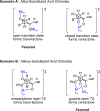
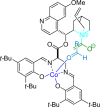





















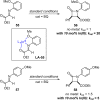
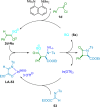
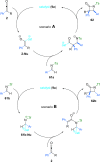






















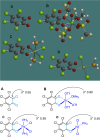

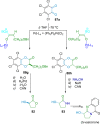
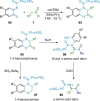


















Similar articles
-
Oxindole synthesis via polar-radical crossover of ketene-derived amide enolates in a formal [3 + 2] cycloaddition.Chem Sci. 2022 Mar 9;13(13):3875-3879. doi: 10.1039/d1sc07134c. eCollection 2022 Mar 30. Chem Sci. 2022. PMID: 35432887 Free PMC article.
-
Iridium-Catalyzed Asymmetric Allylic Alkylation of Boron Enolates to Construct Acyclic All-Carbon Quaternary Stereocenters.Angew Chem Int Ed Engl. 2025 Apr 25;64(18):e202424141. doi: 10.1002/anie.202424141. Epub 2025 Feb 28. Angew Chem Int Ed Engl. 2025. PMID: 39971716
-
Lewis Acid-Activated Reactions of Silyl Ketenes for the Preparation of α-Silyl Carbonyl Compounds.J Org Chem. 2019 Nov 15;84(22):14461-14468. doi: 10.1021/acs.joc.9b01859. Epub 2019 Nov 5. J Org Chem. 2019. PMID: 31642674
-
The Catalytic Asymmetric Allylic Alkylation of Acyclic Enolates for the Construction of Quaternary and Tetrasubstituted Stereogenic Centres.Chemistry. 2024 Apr 5;30(20):e202304289. doi: 10.1002/chem.202304289. Epub 2024 Feb 21. Chemistry. 2024. PMID: 38284328 Review.
-
The Curious Case of Ketene in Zeolite Chemistry and Catalysis.Angew Chem Int Ed Engl. 2018 Nov 12;57(46):14982-14985. doi: 10.1002/anie.201808480. Epub 2018 Oct 17. Angew Chem Int Ed Engl. 2018. PMID: 30328242 Review.
Cited by
-
Enantioselective α-Benzylation of Acyclic Esters Using π-Extended Electrophiles.Angew Chem Int Ed Engl. 2018 Sep 10;57(37):12102-12105. doi: 10.1002/anie.201806742. Epub 2018 Aug 20. Angew Chem Int Ed Engl. 2018. PMID: 30011353 Free PMC article.
-
A metal-free aromative cascade for the synthesis of diverse heterocycles.Org Chem Front. 2020 Apr 7;7(7):913-918. doi: 10.1039/c9qo01336a. Epub 2020 Jan 2. Org Chem Front. 2020. PMID: 32368346 Free PMC article.
-
Photoenolization of α,β-Unsaturated Esters Enables Enantioselective Contra-Thermodynamic Positional Isomerization to α-Tertiary β,γ-Alkenyl Esters.J Am Chem Soc. 2025 Mar 5;147(9):7452-7460. doi: 10.1021/jacs.4c15732. Epub 2025 Feb 24. J Am Chem Soc. 2025. PMID: 39991782 Free PMC article.
-
Enantioselective isothiourea-catalysed α-fluorination of C1-ammonium enolates generated from arylesters.J Fluor Chem. 2025 Apr;283-284:110434. doi: 10.1016/j.jfluchem.2025.110434. J Fluor Chem. 2025. PMID: 40620791 Free PMC article.
-
Si-Directed regiocontrol in asymmetric Pd-catalyzed allylic alkylations using C1-ammonium enolate nucleophiles.Tetrahedron. 2018 Sep 20;74(38):5383-5391. doi: 10.1016/j.tet.2018.04.021. Epub 2018 Apr 10. Tetrahedron. 2018. PMID: 30559533 Free PMC article.
References
-
- Staudinger H. Chem. Ber. 1905;38:1735–1739.
-
-
For the history of ketenes and reviews, see: Tidwell TT. Ketenes. John Wiley & Sons; Hoboken, NJ: 2006. ; Tidwell TT. Eur. J. Org. Chem. 2006:563–576.; Tidwell TT. Angew. Chem., Int. Ed. 2005;44:5778–5785.; Temperley CM. Ketenes, their Cumulene Analogues, and their S, Se, and Te Analogues. In: Katritzky AR, Taylor RJK, editors. Comprehensive Organic Functional Group Transformations II. vol. 3. Elsevier; Amsterdam: 2005. pp. 573–603.; Miller R, Abaecherli C, Said A. Ketenes. 6th ed. Vol. A 15. Ullman's Encyclopedia of Industrial Chemistry; 2002. ; Orr RK, Calter MA. Tetrahedron. 2003;59:3545–3565.; Hyatt JA, Raynolds PW. Org. React. 1994;45:159–646.
-
-
-
For a more involved discussion and leading references, see Ref. 2a.
-
-
- Moore HW, Wilbur DS. J. Org. Chem. 1980;45:4483–4491.
-
- Kresze G, Runge W, Ruch E. Justus Liebigs Ann. Chem. 1972;756:112–127.
Grants and funding
LinkOut - more resources
Full Text Sources
